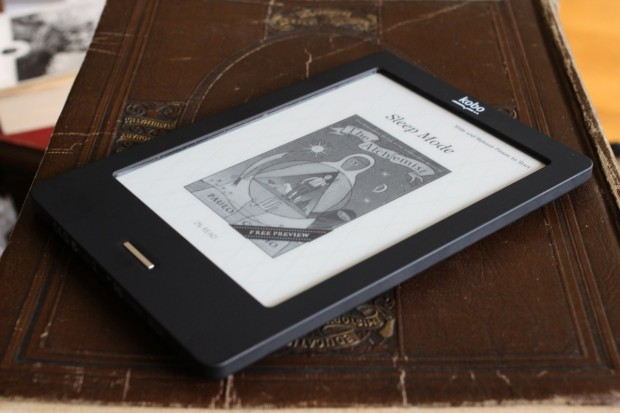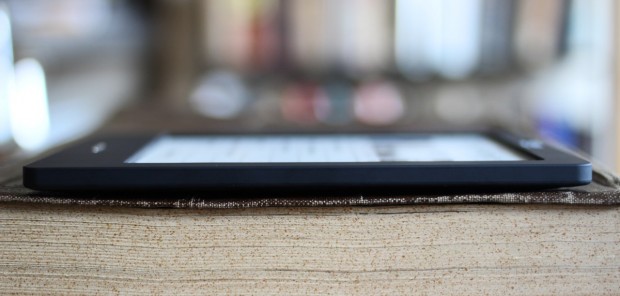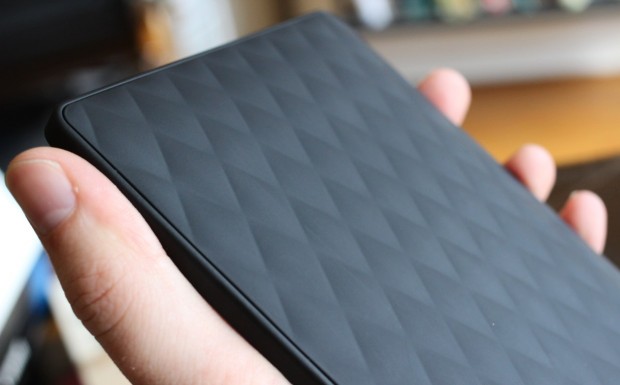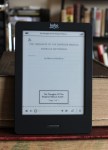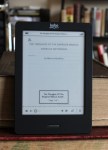
Short version: Superficially similar to the new Nook, but the Kobo is perhaps even simpler, and the form factor is slightly more book-like. If you don’t need 3G or the other perks of the Kindle ecosystem, and just want a straightforward e-book reading device, this Kobo could be a good match.
Features:
- 6-inch touchscreen Pearl E Ink display
- 2GB (~1.5GB accessible) internal space
- MicroSD cards slot
- Supports ePub and PDF (and unofficially CBZ, CBR, rtf, HTML, and txt)
- Update: Kobo recently added truly awesome custom fonts
- MSRP: $129.99
Pros:
- Extremely simple operation
- Design and quilted back make it a comfortable device to hold
- Touchscreen elements quick to respond (i.e. keyboard, sliders)
Cons:
- Not really a better reading experience than other devices (though not a worse)
- No 3G option
- Lacks the bells and whistles of Amazon’s Kindle services
Full review:
It’s easier to show the functions of the Kobo than describe them, so watch this brief video of a few normal uses of the device to get a feel for how it responds to touch.
In addition to what’s shown in the video, there’s unofficial support for some image and archive files, and somehow I managed not to show the Library — but it’s what you expect.
 The question here isn’t really what does the Kobo do, but what does the Kobo do differently? In many ways it is nearly identical to the Nook, at least to the end user. Same screen, same speed, same page caching, etc. It has fewer buttons (just the one home button and a sleep/wake switch) and of course accesses a different store, but the actual e-reading experience will be mostly the same.
The question here isn’t really what does the Kobo do, but what does the Kobo do differently? In many ways it is nearly identical to the Nook, at least to the end user. Same screen, same speed, same page caching, etc. It has fewer buttons (just the one home button and a sleep/wake switch) and of course accesses a different store, but the actual e-reading experience will be mostly the same.
The UI is similar to the previous Kobo, which is to say clean and unassuming. Navigating by touch improves it, I think, and the Pearl screen does what it does, equally as well as the other devices that have it. Navigation is now achieved by touching the page numbers at the bottom of books or PDFs, which then brings up your scrub bar, font options, and so on.
You have access to the Kobo e-book store, which has plenty of titles — most of the big bestsellers and tons of free books. You can also drag and drop your own ePub, text, or PDF files onto the MicroSD card and it’ll find them, including if they’re organized in folders. PDFs are easy to zoom in on and scroll around, though their scanned text doesn’t fare so well on e-paper screens.
The device itself is light and comfortable to hold, the lovely Kobo trademark quilted back being soft and inviting as always. It really has been reduced to just a screen and a button, there’s very little to say but that it’s nice. Personally I like how it looks better than the Nook and the Kindle both. It also comes in several finishes, though the black is probably the most tasteful.
Conclusion
It’s a close race, but if you’re just going to be using this device for plain old reading, the Kobo is in my opinion the best bet right now. If you’re interested in social recommendations, 3G, apps, or any of the other bonus features found on the Nook and Kindle, it’s best to go with one of those, obviously, but the totally uncluttered and ultra-simple operation of the Kobo eReader Touch Edition makes it a perfectly good choice for an e-reading novice or purist.
Product page: Kobo eReader Touch Edition
